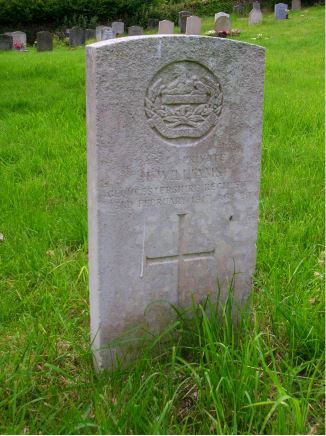8th Battalion, Gloucestershire Regiment

As is so often the case, no Army Service Record has survived for Private Williams (the majority having been lost in the Blitz on London in 1940). However, sufficient details in other (surviving) records do throw some light on his military service and early life.
Hubert Williams was born in Eastleach Turville in 1897. His father was John Thomas Williams (1864-1908), a labourer. His mother was Caroline (née Hutson: 18587-?). The couple had three sons together and it would appear that Caroline had a daughter, from a previous relationship, prior to marrying John in 1885. The 1911 Census indicates that there were two other children from her marriage, who must have died in infancy.
The family lived in Eastleach Turville and the 1901 Census shows John as head of the household but without occupation; the census form notes that he was blind. The family probably survived by Caroline taking in washing, as she is shown as a ‘laundress’, operating from home.
John Williams died in 1908; the record of his burial states that he ‘died suddenly’. Caroline continued to live in the village and at the time of the 1911 Census was living with two of her sons, Joseph and Hubert. The latter was now aged 14 and employed as a farm labourer.
To mark the centenary of the Great War, between 2014 and 2018 some local research was undertaken on the names inscribed on the village war memorial. This was published online and www.eastleach.org/eastleach-war-memorial-hubert-williams does give a detailed account of Hubert’s time in the Army. The acknowledgements indicate that this information was obtained via the archivist of the Soldiers of Gloucestershire Museum at The Quays in Gloucester. What is written is as follows:
Hubert enlisted with the 8th Battalion of the Gloucestershire Regiment in Cirencester on or around 10 September 1915. It is possible that his two brothers may also have been in the Gloucesters but it is impossible to differentiate between several of the same name in the records as no birthplace is given for any of them. Either way, they must have returned safely.
On 7 August 1916, the battalion detrained at Bailleul, south-west of Ypres, and marched into billets at Aircraft Farm (Dranoutre) south of Kemmel Hill. The following day there was an inspection of smoke helmets, goggles and other kit and by the evening of 10 August the battalion was moving past Daylight Corner to relieve the North Staffordshire Regiment on the front line between Wytschaete and Messines, the Messines Ridge. This was in the very heart of the Flanders battlefields. Hubert’s war was not going to last long. It was reported in the battalion diaries for 11 August that it ‘was very quiet except 4.30-5.30pm when the enemy active with bombs and trench mortars on our support work on parapets and trench boards’. This was the day that Hubert was reported as being wounded. He would have been taken to a field hospital behind the lines and, against all odds, made it back to the 2nd Western General Hospital in Hove.
Hubert finally passed away in Hove on 23 February 1917; he was 20 years old. He was buried on 27 February. The Burial Register records him as being in the 11th Gloucestershire Regiment and also that he died of wounds received in July 1916. His death certificate implies some type of bacterial infection — sadly, no antibiotics were available then. However, there is also a suggestion of some underlying heart condition which had been evident for eighteen month. He is only one of two of those remembered on the War Memorial who came home and he is buried in a Commonwealth War Grave in Eastleach Turville churchyard.
Private Hubert Williams was aged 20 when he died and was unmarried. A recently released Pension Record Card stated that he died as a result of a gunshot wound to the abdomen and heart disease. The Western Daily Press of 23 March 1917 carried a casualty notice which stated ‘previously reported wounded, now reported died of wounds’.
Researched by Graham Adams 22 September 2020
